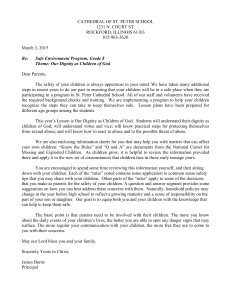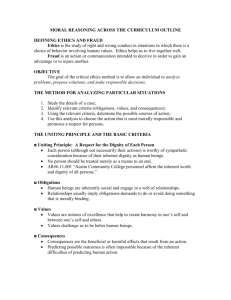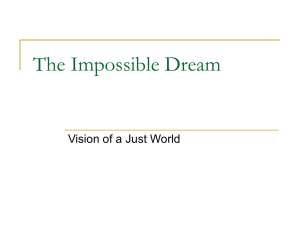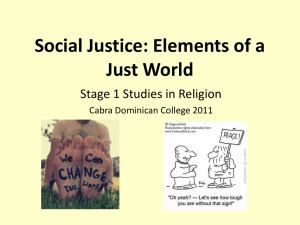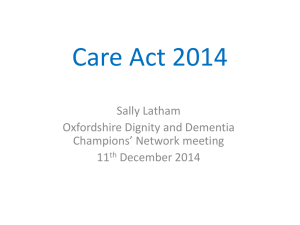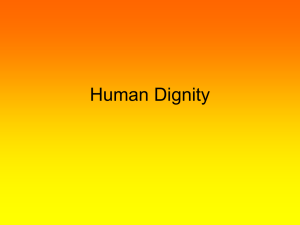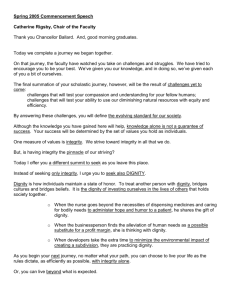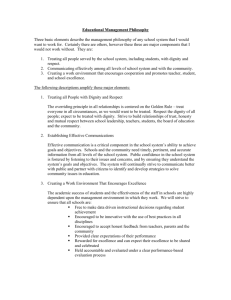Human Life
advertisement
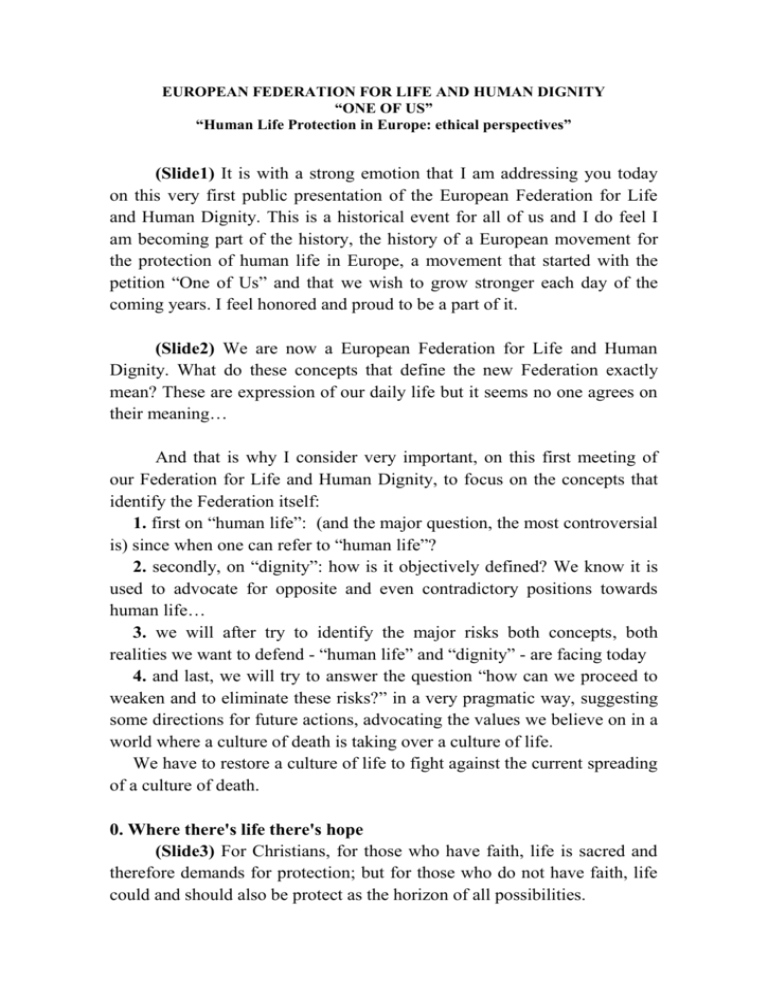
EUROPEAN FEDERATION FOR LIFE AND HUMAN DIGNITY “ONE OF US” “Human Life Protection in Europe: ethical perspectives” (Slide1) It is with a strong emotion that I am addressing you today on this very first public presentation of the European Federation for Life and Human Dignity. This is a historical event for all of us and I do feel I am becoming part of the history, the history of a European movement for the protection of human life in Europe, a movement that started with the petition “One of Us” and that we wish to grow stronger each day of the coming years. I feel honored and proud to be a part of it. (Slide2) We are now a European Federation for Life and Human Dignity. What do these concepts that define the new Federation exactly mean? These are expression of our daily life but it seems no one agrees on their meaning… And that is why I consider very important, on this first meeting of our Federation for Life and Human Dignity, to focus on the concepts that identify the Federation itself: 1. first on “human life”: (and the major question, the most controversial is) since when one can refer to “human life”? 2. secondly, on “dignity”: how is it objectively defined? We know it is used to advocate for opposite and even contradictory positions towards human life… 3. we will after try to identify the major risks both concepts, both realities we want to defend - “human life” and “dignity” - are facing today 4. and last, we will try to answer the question “how can we proceed to weaken and to eliminate these risks?” in a very pragmatic way, suggesting some directions for future actions, advocating the values we believe on in a world where a culture of death is taking over a culture of life. We have to restore a culture of life to fight against the current spreading of a culture of death. 0. Where there's life there's hope (Slide3) For Christians, for those who have faith, life is sacred and therefore demands for protection; but for those who do not have faith, life could and should also be protect as the horizon of all possibilities. On the 3rd century BC, Aristotle, in his Nicomachean Ethics, refers to human life as an ongoing development of our actualizing of a potentiality, in an endless flourishment until death. It is death that defines the level of perfection the person was able to achieve during his life time. There are then, not only religious reasons to cherish life, but lay people should also celebrate it even more then those who have faith: for the believers there is life, eternal life, after the present physical life; for nonbelievers, life on earth run out all possibilities. [Nevertheless, our societies are keen today to advocate different ways for different situations to hasten death, to cut the horizon of life shorter, promoting more a culture of death, then a culture of life]. (Slide4) As a matter of fact, it is always possible to translate reasons of faith into secular reasons, and I consider that is what we have to do: adopt always a lay discourse in order to address to all citizens without exception (and not only to those who have faith). As we just saw, it is always possible to translate reasons of faith in to secular reasons [because Christianity is not only a religion, but also a culture]. Let me, quickly, move to the first of the four points I want to focus on. 1. (the concept of) Human Life (Slide5) and the question: since when one can refer to “human life”? 1.1. From the biological perspective that is from a scientific point of view, life begins with the zygote the single cell resulting from the fusion of both gametes. This fact, this scientific and objective fact is not really open to discussion: the zygote is a new form of life qualitative different from the gametes that were at its origin. The zygote is a new life. 1.2. Being a new life, and being born from human gametes – sperm and ovocyto -, gametes of the human species, that zygote is life and cannot be any other kind of life, but human. The zygote is a human life. 1.3. It follows a third question: is it a human being? Biologically speaking it is known that the nidation or implantation of the embryo in the uterus is accomplished around the fourteen day of gestation. Until then, pregnancy might not take place, because the embryo can fail the implantation; also, until then, it is possible for the embryo to divide itself originating twins [it is appropriate to remember Boethius on his famous statement that “a person is an individual substance of a rational nature”]. Therefore, (although the new human life is undoubtedly a biological entity, it is not possible to refer to “one” human being before the fourteen day; likewise, it is undoubtedly a human being after the fourteen day of gestation. (the concept of “being” is defined by ontology, a philosophical branch). 1.4. The fourth question is: is it a person? This question cannot be answered by science. The concept of “person” is a philosophical one, and several hypotheses can be justifiably put forward: a) If one considers that “person” and “human being” are synonymous it will consider the fourteen days embryo a person - this is a biological perspective. b) If one considers that to be a person one has to have an autonomous life, it will consider that only after birth will the human being in gestation became a person - this is a juridical perspective. c) If one considers that “person” is an ethical category, grounded on the fact that humans beings are not only the product of nature but also of their own actions, with the capacity to shape themselves along their life, if one considers that “person” corresponds to the level of flourishment each one achieves, then not all human beings are persons and some might not even get to be - this is a philosophical perspective. (Slide6) In any case, the decisive question is not whether that human being in (a biologically continuous) gestation is a person or not (and we should not get trapped on this issue), but if human life is worthy more or less according to its level of development, in a gradualist position (do not engage on quarrels one cannot win: the concept of “being” is defined by ontology, and the one of “person”, by ethics. They are not of an objective nature). If one accepts this presupposition, this gradualist position towards life, then an adult worth more than a child, and an old person more than an adult – what common sense will not accept. Therefore, I consider we should stick to the facts and draw logical conclusions; we should ground moral claims into objective facts, scientific facts. 2. (the concept of) Human Dignity (Slide7) and the question: how is it objectively defined? The concept of “person” as an ethical category also helps us to understand the full meaning of “human dignity”. Each person is singular, is unique, because is self-shaped by its own actions throughout life, within a concrete space, time and circumstances. Consequently, there is not two identical persons not even the biologically defined as “identical twins”. Therefore, no one is equivalent or can be substituted by another person or anything else. “Human dignity” relies on this uniqueness of each person, and the intrinsic equal value of each uniqueness, of all persons. From an historical perspective, Cynics and Stoics are the first ones to focus on the importance of “human dignity” and to define it as an inherent quality to all human beings, equivalent to recognize the equal, and unconditional, worth of all human beings [a worth grounded in reason and moral capacity, rather than on traits that depend on fortuitous natural or social arrangements (and differ human beings from all other beings) The perspective that “human dignity” results from the creation of Mankind by God and at His image and resemblance comes later (and differ human beings from all other beings). And, although it adds an important reality to the concepts, it only addresses to believers (the sanctity of life). It was Kant’s definition of “human dignity” that most deeply entered in to our culture. Kant [on is Grounding for the Metaphysics of Morals, in 1785, who] clearly stats that everything has a price except persons; persons have dignity, that is, they are beyond any price, they cannot be quantified (its complete reality cannot translated into any kind of quantified value; its value is total), objectified (its dynamic reality cannot be reduced any kind of inert object), functionalized (its intrinsic reality cannot be taken by the roles played in life). (Slide8) I believe we should refer to the historical and philosophical foundations of human dignity which means: - the absolute, unconditional, and equal worth of all human beings; - regardless of the level of development (quantity: embryo or adult) or any physical or psychological features (quality: handicap or so called normal); - being a subject of rights (non objectifiable or reduced to an object of someone: there is no right to have a child); - valuing in itself as an end (and not a mean for someone, functionalized: cannot be produced under certain characteristics for someone’s satisfaction) And, secondly, we should uncover the contradictions that spread in public opinion. 3. The threats to human life and dignity (Slide9) and the question: which are the major risks “human life” and “dignity” are facing? The major threats are at the beginning and end of human life, and there are many examples. At the dawn of human life: - abortive devices - abortion - heterologous assisted reproduction - surrogate motherhood - surplus embryos - embryo selection - “wrongful life” - embryo production for biomedical research (Slide10) A world map concerning abortion gives us a clear idea of the current situation. (Slide11) At the setting of human life: - therapeutic obstinacy - lack of palliative care - euthanasia - assisted suicide (Slide12) A Europe map concerning euthanasia gives us a clear idea of our situation. (Slide13) The major threats are at the most vulnerable stages of human life when the power of the stronger makes weight, contradicting what society defends and pursues: - solidarity towards the most vulnerable (who, on the contrary, appear to be disposable at the will of those who have power – the women towards the embryo –, or abandoned – the old people, the terminally ill – to whom simple and economic ways out of life are offered); therefore, human life is not protected, cherished and respected; - equality among all human beings grounded on their unconditional dignity (that, on the contrary seems to be subordinated to certain features, age – unburned children or senile people –, gender – chosing the embryo sex –, handicapped – level of capacity and also of competency); therefore, dignity is not complied what give raise to further injustices in the world. 4. Addressing the risks: (Slide14) How can we proceed to fight the risks of a culture of death and help to restore a culture of life? I would suggest to: - keep the discourse at the secular level, addressing all citizens, without exception; - ground moral claims on scientific knowledge (spreading it) and argue within a historical and philosophical well established framework; - draw logical and unavoidable conclusions for action from the values and principles theoretically enounced; - identify and stress the contradictions between the common morality correctness and its application to concrete situations; - awaken to the need of coherence between principles advocated, and between principles and actions followed; - help solving people’s problems (do not “close a door without opening a window”: talk about abortion together with family planning; talk about euthanasia together with palliative care).
